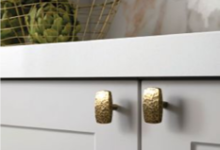
10 Most Popular Kitchen Countertops
You’re probably excited to choose kitchen countertops if you’ve been looking at different colors and patterns and materials on social media sites such as Houzz and HGTV . So, you think you know what you want?
With so many kitchen countertop options available on the market today, it’s difficult to decide which ones are right for you and your new kitchen. It is likely that you will have trouble deciding when you consider all the available options.
When it comes to countertops, you may not think of more than a few types of materials, such as granite and laminate. However, there are many (many!) other countertop materials available. And manufacturers add more each year.
We present here some kitchen countertop ideas to consider for your new kitchen. While they vary in look, feel, composition and care, they all have their pros and cons.
How to Decide Which Kitchen Countertop is Best for You
As you’ve been considering your kitchen countertop options, you have to wonder: “which is the best?”
Choosing the best kitchen countertop material is totally subjective. In other words, what appeals to you, what you find attractive. Truthfully, any one of the available materials could make a beautiful and functional countertop.
However, there are also objective criteria you can use to determine which countertop material is best for your lifestyle. For example, if you use your kitchen mostly for socializing, appearance may be most important to you. On the other hand, in a kitchen where cooking happens regularly, stain- and heat-resistance may be what you want.
When evaluating which countertops are best, here are characteristics to consider and questions to ask:
- Appearance: What are the appealing qualities of the countertop material?
- Value: What are you getting for the money?
- Stain-resistance and clean-up: How well does the material resist stains?
- Heat resistance: Will hot pots discolor or burn the countertop surface?
- Resale value: Does the countertop add value to your home for prospective buyers?
Most Popular Countertop Materials
According to a survey by Kitchen + Bath Design News, quartz continues to be the most popular and most requested kitchen countertop material. We’ve listed the others below in descending order of popularity.
- Quartz
- Quartzite
- Granite
- Wood
- Solid Surface
- Marble
- Sintered Stone
- Concrete
- Laminate
- Metal (Stainless steel)
- Glass
- Tile
1. Quartz

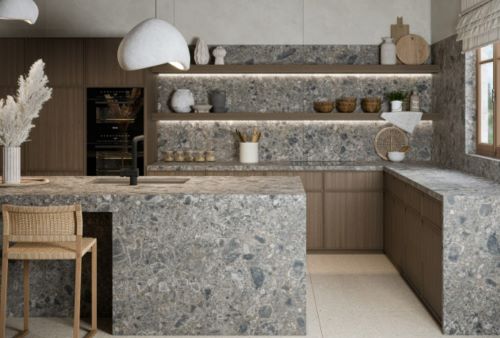
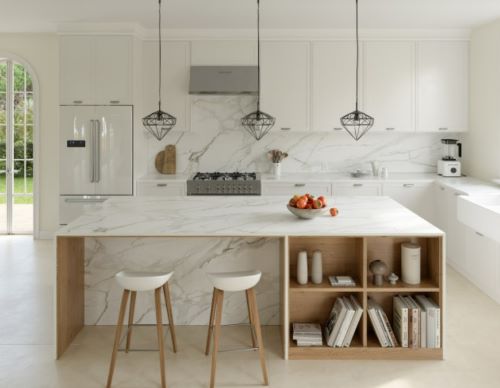
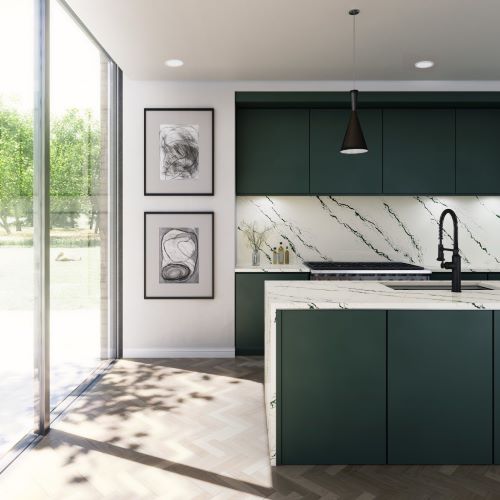
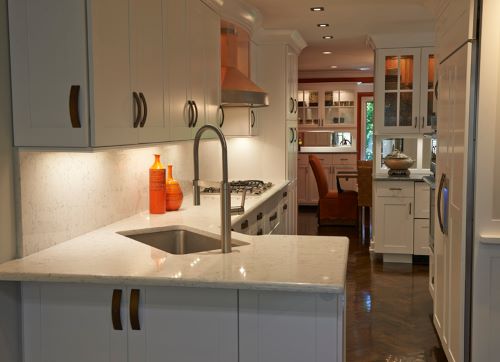
Quartz countertops are actually “engineered stone”, not a natural stone. They’re made using a combination of 93% quartz particles and other minerals mixed with resins that gets shaped into slabs. It’s not surprising this is the most popular kitchen countertop material when you consider its many advantages.
The best know manufacturers of Quartz countertops are Caesarstone, Silestone and Cambria Quartz. Each of these websites contains a wealth of information regarding their products, together with photos.
Pros.
- Non-porous
- Stain-resistant
- Doesn’t need sealed
- Available in a wide variety of colors and patterns
- Looks like Granite or Marble
- Has no seams, creating an uninterrupted surface
- Color is uniform. You’ll get a perfect match throughout your kitchen.
- Extremely durable
- Doesn’t crack like Granite
- Heat resistant
- Resistant to cuts and scratches (although a cutting board is recommended)
Cons.
- Not natural stone
- Priced similarly to Granite (on the more expensive side)
2. Quartzite

Quartzite has become a popular kitchen countertop material in recent years. In fact, it’s now #2 on the list of most requested countertop materials.
Many people ask what is the difference between quartz and quartzite, and the answer is easy. Quartzite is a metamorphic rock that is an extremely strong and durable natural stone, while quartz is an engineered (i.e., manmade) material.
Pros.
- Strong
- Durable
- Doesn’t stain. scratch or etch
- Harder than granite
- As beautiful as Marble
- Naturally occurring colors and patterns not found in other stones
- Heat and fire resistant
- Can be used in outdoor kitchens
Cons.
- Expensive
- Requires sealing
3. Granite

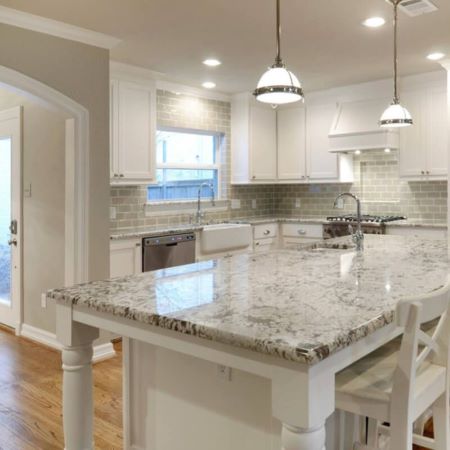
At one time, not long ago, granite was the most popular choice for kitchen countertops. Although it is still desirable, both quartz and quartzite have overtaken it as America’s favorite countertop choice.
The MSI Surfaces website has information about and many photos of Granite. It’s a good resource for getting started with a Granite selection if you’ve always wanted Granite countertops in your kitchen.
Pros.
- Natural patterns are stunning and unique
- Heat resistant
- Hard-wearing and holds up well (if properly sealed*)
Cons.
- Expensive
- *Requires sealing every one-two years
- As a natural stone, it can have imperfections
- Cracks may occur if not installed correctly
- Can have seams
4. Wood

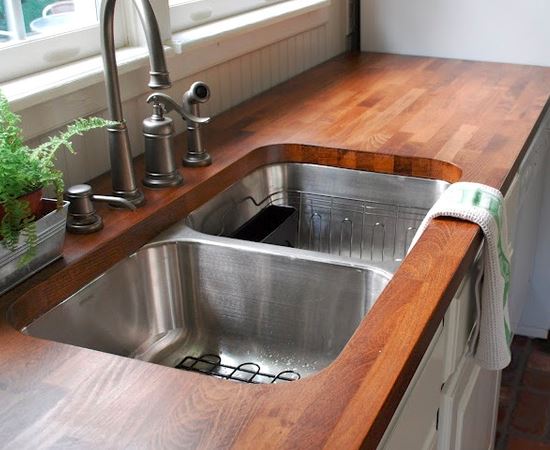

The primary reason people choose wood for their kitchen countertops is because of its natural beauty. However, incorporating natural materials, such as wood countertops, into a kitchen is part of the wellness kitchen. And the wellness kitchen includes natural products that promote a sense of well-being.
Grothouse Wood Surfaces is a well-respected supplier of wood kitchen countertops for remodeled kitchens. You can get ideas from their website.
Butcher block is constructed from pieces of hardwood Maple laminated together with glue for strength and stability. If an entire kitchen filled with butcher block countertops is too much butcher block for you, it lends itself very well to an accent space, possible on the island or by the range. John Boos & Co is well known for its butcher block.
Pros.
- Provides a warmth unlike other countertop materials
- Available in a variety of choices
- Endless stains, finishes and styles to choose from
- An excellent work surface
- Knife and burn marks can be sanded out
- Can be sanded and refinished every 10-20 years
Cons.
- Must be sealed because it is porous and germs can multiply
- Requires maintenance with mineral oil to prevent water absorption
- Easy to scratch, dent and burn
5. Solid Surface

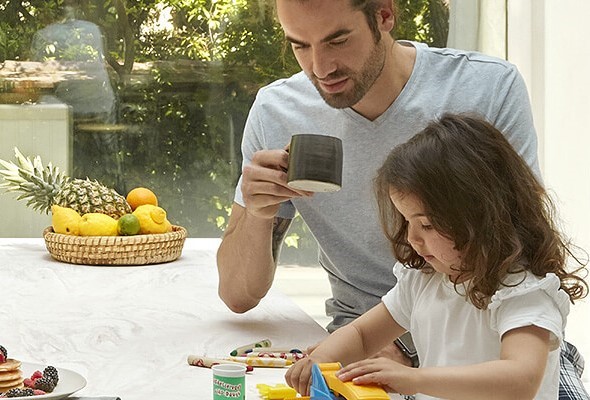
Solid surface kitchen countertops are a man-made material, created from a combination of acrylic particles and resins that have been pressed into sheets. When first introduced by DuPont back in 1967, it was considered a luxury product. The most well-known brand of solid surface materials is Dupont Corian. The latest from Corian is you can get it with a built-in charging surface to charge your smart devices wirelessly. The built-in charger is available in every Corian color. How does that work, you ask? Energy is transferred safely from below the Corian surface, and it stops when the battery is full. See photos and get more info on the Corian website.
Pros.
- Resists stains
- Any damage can be sanded out
- Seams are almost invisible
- Consistent color throughout the countertop Hygienic / germ-free
Cons.
- Can be damaged by hot pans
6. Marble

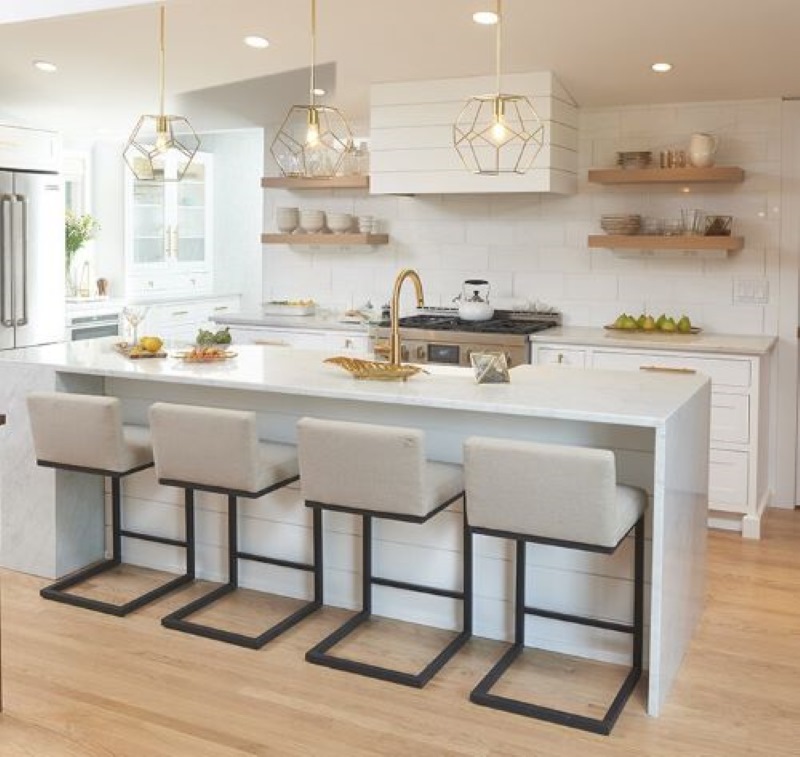
Marble is prized for its classic, elegant white color with gold, beige or gray veining. Especially popular is Calacatta Marble, a gorgeous natural stone. Marble.com has information and photos of different types of marble but remember – each slab is unique so their photos are only representative of what you may get.
If you decide on marble for your kitchen countertops, go to the stone yard and ask to see the entire slab to ensure you are satisfied with the color and veining.
Pros.
- Each piece is beautiful and unique
- Water resistant
- Heat proof
- Available in honed or polished finishes
Cons.
- One of the more expensive stones
- It scratches
- Very susceptible to stains. New sealing products can reduce the possibility of damage, but no acids, like lemon or lime juice, wine and vinegar, on Marble countertops
- Once damaged, it is hard to repair
- As a soft stone, it’s not a good choice for kitchens that get used hard
7. Sintered Stone

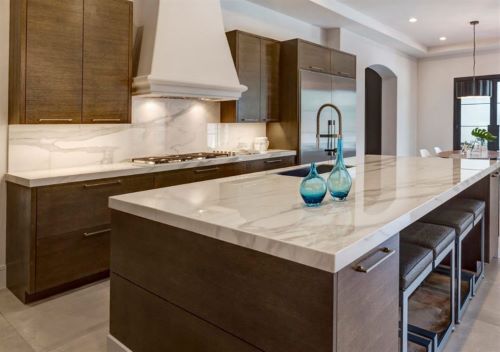
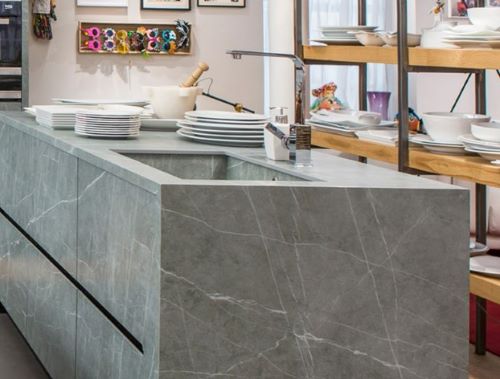
More and more homeowners are choosing sintered stone, a manmade material, for their kitchen countertops. Specifically because sintered stone is versatile, beautiful and practical. It is almost impossible to distinguish from natural stone. Sintered stone requires minimum maintenance. Plus you can place a hot pan on your work surface without having to worry. In addition, it is also non-absorbent, meaning it can’t be stained or ruined by water absorption. Another benefit: it’s weather resistant so it’s an ideal choice for outdoor kitchens.
Pros.
- Can withstand heat and high temperatures
- Highly stain resistant
- Resists scratches
- Non-absorbent
- Hygienic – resists bacteria and mold
- Easy to clean
- Durable material
- Weatherproof, weatherproof and stainproof
- Unaffected by heat or cold
- Non-porous which means the stone doesn’t need sealing
Cons.
- Designs are printed on top of the material, which leaves the sides plain
- Will chip or crack when something is dropped on it, especially on the edges
- Chips and nicks are difficult to repair
- On the expensive side
- Requires special installation by a certified fabricator
8. Concrete

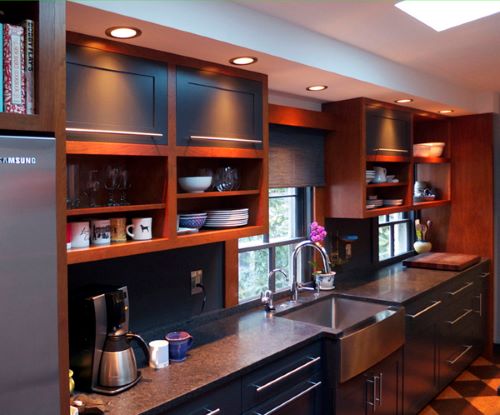
Concrete kitchen countertops are popular with homeowners who want something unique they can design themselves. They embed pieces of tile, stone, glass, shells or other materials in the concrete to create a one-of-a-kind work of art. It can be pigmented to produce any color.
Pros.
- Extremely hard and tough
- Won’t easily scratch if sealed properly*
- Highly heat resistant
Cons.
- It can crack
- Expensive
- *Needs to be sealed every 1-3 years
- Extremely heavy
- Expert installation required
9. Laminates

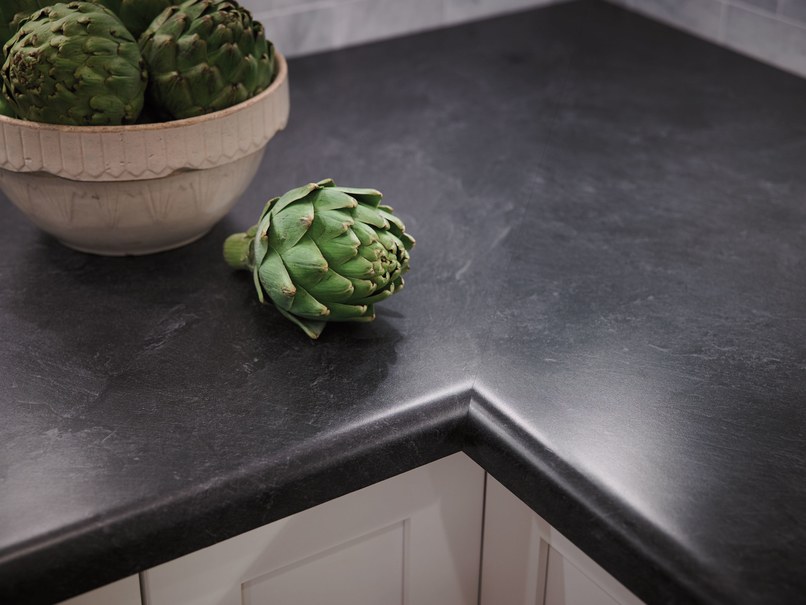

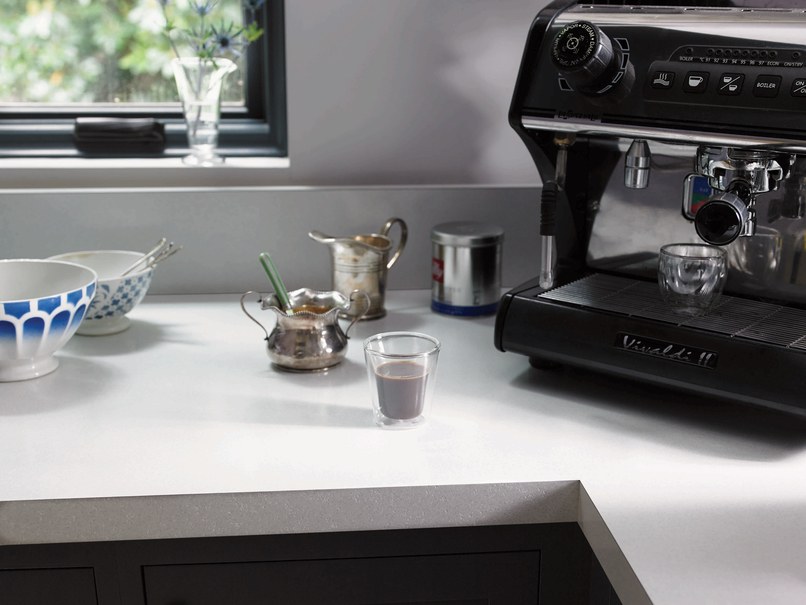
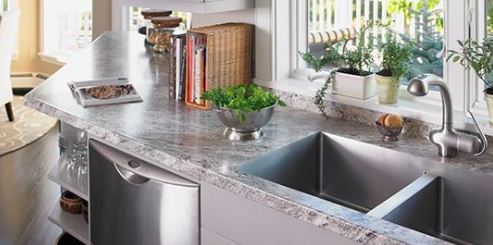
Today’s laminates are not what your Grandma had in her kitchen. They’re made from recycled paper that has is laminated onto a particleboard (MDF) core. The Formica and Wilsonart websites have product information and inspirational photos.
If you love the look of quartz or marble or even reclaimed wood but you can’t afford them, you can get the same looks in laminates. True. They’re affordable, easy-to-care-for, durable and look like the real thing.
A recent addition to the Wilsonart product offering is the Calacatta Quartz collection, inspired by Calacatta marble.
Pros.
- Relatively inexpensive
- Easy to clean
- Thousands of colors and patterns
- Long lasting
- Stain resistant
- Can be recycled
Cons.
- Prominent seams
- They scratch and chip
- Don’t add value to the home because they are considered a “low-end” product
10. Stainless Steel

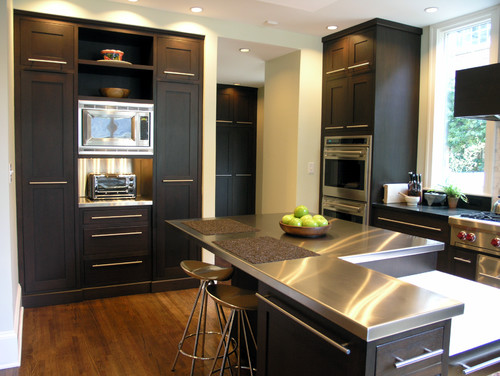
Stainless steel is a chic kitchen countertop material that has been traditionally seen in industrial kitchens. However, now stainless steel can now be found in high-end residential kitchens. Stainless steel gives off a subtle brightness with a lovely patina. In addition, it complements many different styles of cabinets, flooring and kitchen styles.
Pros.
- Easy maintenance. Simply wipe down with a mild cleaner.
- Very strong
- Will last a long time
- Non-porous so it’s anti-bacterial
- Stain resistant
- Heat resistant. Impervious to scorch marks
Cons.
- Very pricey
- Fingerprints show Susceptible to dents
11. Glass


Glass used as a kitchen countertop is one of the most versatile and unique materials available. If you want a countertop that’s different from your neighbor’s, glass may be exactly what you’re looking for. The distinctive look of a glass countertop can give your kitchen a modern edge. And it pairs well with stainless steel.
Recycled glass manufacturers primarily use materials from curbside recycling and demolished buildings. That glass gets combined with resin or cement binders to produce a slab that you can use as a countertop. Your counterop will be unique because a diverse blend of glass is used in each countertop.

Most recycled glass countertops feature a colorful mosaic of shards encased in the binding material to produce a terrazzo look.
Pros.
- Available in a wide variety of styles, colors, and textures
- Can be shaped and formed into an endless number of different styles
- Long-lasting
- Non-Porous
- No sealant required
- Won’t show any wear or discoloration
- Extremely heat resistant. Safely place hot pots and pans right on the surface without damage
- Easy maintenance
- Hygienic. No cracks or crevices for dirt and bacteria
- Eco-friendly.
- Less expensive than natural stone or metal materials
Cons.
- Sharp and/or heavy objects can cause cracks, chips or dents
- Difficult and costly to repair.
- Higher cost of installation
- When not sealed correctly, cement binders can stain when exposed to highly acidic foods such as tomato sauce or red wine
12. Tile

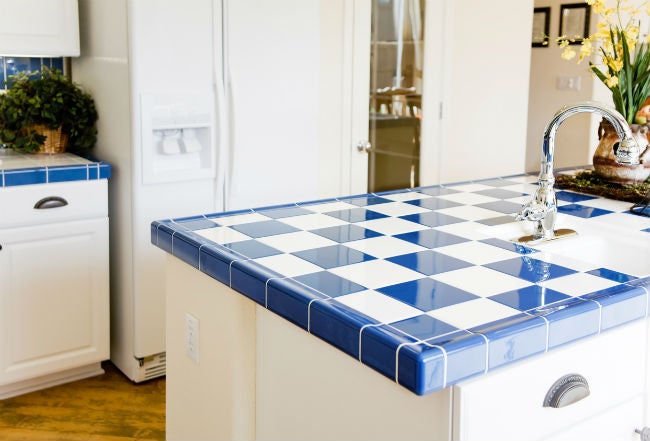
Ceramic tile creates a classic look for your kitchen countertops that will stand the test of time with proper care and maintenance. Customize the tile countertops to your personal taste since any combination of colors, patterns and textures is available.
Pros.
- Choose from many colors, patterns and textures
- Cost effective
- Holds up well to stains
- Resistant to hot pots
- Maintains good looks for years, with proper maintenance*
Cons.
- *High maintenance. Grout needs resealing every year
- Difficult to keep grout clean
- Uneven surface because of seams
- Negative influence on re-sale value of the home
Conclusion
We’ve provided information about the most popular and widely selected kitchen countertop materials. Not included here are other available materials, such as soapstone and others.
In the end, the decision is up to you. It all comes down to what you like and the look you are going for in your new kitchen. And how much you want to spend on countertops.
Your kitchen designer will help guide your selection and make sure you get the countertop that matches the look you like and the price you can afford.
KDP exists to offer insight and advice about all things related to kitchen remodeling. Our goal is to connect homeowners with talented, experienced kitchen designers who live and work in their communities. We are a serious resource for anyone preparing to remodel their kitchen so they can make the best possible choices about designers, contractors and products.



